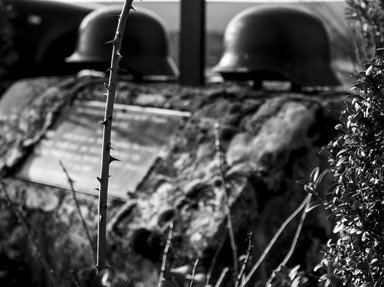Quiz Answer Key and Fun Facts
1. The 1962 movie, "The Longest Day" was a depiction of events which occurred during which of the following wars?
2. This Oliver Stone film from 1986 was based on the real-life soldiering experiences of the film's director, Mr. Stone himself.
Starring Tom Berenger, Willem Dafoe and Charlie Sheen, what was the name of this movie, that depicted U.S. involvement in the war in Vietnam?
3. Where was most of the 1968 movie, "The Green Berets", starring John Wayne, actually filmed, during the height of the war in Vietnam?
4. A movie about WW2 was based on the activities of the Demolition Section of the Headquarters Company of the 506th Parachute Infantry Regiment, 101st Airborne Division.
What was the name of this movie, that was loosely based on this group of soldiers who were collectively known as The Filthy Thirteen?
5. The 1957 classic "The Bridge On The River Kwai" was based on a true event that occurred during WW2.
6. What 1980 film about WW2, starring Lee Marvin and a young Mark Hamill, actually began with a scene involving an Army Private that occurred at the end of WW1, only to have a similar scene, involving the same man as a Sergeant, occur at the end of WW2, near the end of the movie?
7. George, Francis/"Frank", Joseph/"Joe", Madison/"Matt", and Albert/"Al" Sullivan were brothers from Iowa who all died during the sinking of the USS Juneau during the course of WW2.
What 1998 Steven Spielberg movie could have used this data as the premise for its plot?
8. Okay, I hear you. You want to know a bit more about the experiences of servicemen in POW camps, right?
Okay, I'm going to list some folks that starred in this 1963 movie about an actual German WW2 prisoner of war camp. Let's see if you can identify the movie by title, based on these names:
Steve McQueen
James Garner
Donald Pleasance
Charles Bronson
James Coburn
Richard Attenborough
9. In 2008, Bryan Singer directed this film about Colonel Claus von Stauffenberg; one of the key historic figures involved in a 1944 plot to kill Adolf Hitler.
The movie, "Valkyrie", starred which American actor as Colonel Stauffenberg?
10. In Stanley Kubrick's 1987 release of "Full Metal Jacket", many of the recruits acquired nicknames, (much like those given to actual recruits by their peers).
There was Cowboy (a role played by Arliss Howard), Joker (played by Matthew Modine) and of course, there was a recruit who had been given the nickname Gomer Pyle by his Gunnery Sergeant. This role was played by Vincent D'Onofrio.
What was this troubled and tormented character's real name in the movie?
Source: Author
logcrawler
This quiz was reviewed by FunTrivia editor
skunkee before going online.
Any errors found in FunTrivia content are routinely corrected through our feedback system.
